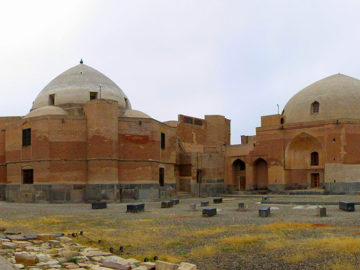Ardabil province is located in the northwest of Iran, where its neighbors include the provinces of Zanjan, Gilan, and East Azerbaijan as well as the country of the Republic of Azerbaijan. The mountainous position of this province and the altitude difference varying from 40 meters in the Moghan plain (the lowest point) to 4811 meters in the Sabalan summit (the highest point) made a diverse weather condition in this province. In fact, it is known as a four-climate region i.e., the warm Mediterranean, temperate Mediterranean, cold mountainous, and temperate mountainous.

Ardabil province with about 17,800 square kilometers is the 24th biggest province of the country. According to the latest country division in Iran, it has ten cities and about two percent of the country’s total population live in this province. Its center is Ardabil that whose old name was Artavil meaning “The City of Righteousness”.
Most residents of Ardabil province are called Azari who speak Azerbaijani. In some parts of the province including Talysh and Tat, the indigenous people speak with Talysh and Tati languages. Ardabil was considered a part of East Azerbaijan province until 1993 but became an independent province following the approval of the government.
Therefore, the history, culture, and events of Ardabil province are mixed with the history of Azerbaijan territory. Most historians attribute the construction of Ardabil to Peroz during the Sassanid Empire (224-651 A.D.). It was also one of the important cities of Azerbaijan during the Parthian Empire (247 B.C. – 224 A.D.). Ardabil was destroyed following the invasion of Mongol and although soon its reconstructions began, it took years the province to return to the previous flourished time.
During the Safavid Dynasty (1501-1736), Ardabil experienced its zenith. According to the inscriptions that remained from this era, Sheikh Safi al-Din Ardabili, the ancestor of the Safavid kings built his home and monastery in Ardabil to develop his religious activities. This monastery had the privilege of being located on the roads of Gilan, Aran, Azerbaijan, and Anatolia with the spiritual influence of Sheikh Safi himself. At the time of Sheikh Jouneid, the monastery turned into a Shiite center.
In recent years, the tomb of Sheikh Safi al-Din Ardabili as one of the important tourist attractions of the province has been registered in the UNESCO’s World Heritage List.
In addition to Sheikh Safi al-Din, Shah Ismail I, his wife and a number of Chaldoran martyrs are also buried in the tomb. What makes the place incredibly appealing is the combination of various decorations such as mosaic tiles, muqarnas (vaulted decorations), stucco of inscriptions, paintings, silvering, and gilding.
Ardabil province is also known for its beautiful nature with its natural attractions of Sabalan Mountain, Sabalan Lake, Shorabil Lake, Neor Lake, Sareyn Hydrotherapy Complex, Asalem to Khalkhal beautiful road, Heyran Road, Fandoqlu Forest, and Alvars Ski Resort. Similar to other parts of Iran, Ardabil has its own handicrafts and cuisines. For example, Varni, a woven floor cover, is the most famous handicraft of the region among the nomads of Shahsevan.
There is also another form of weaving handicraft known as Masnad, which is a small carpet with sharp colors and nature-related patterns. Of its souvenirs, Sabalan honey, and Ghareh Halvah are the most famous ones. Ghareh Halva is a black sweet nourishing paste which is a mixture of natural wheat flour, sugar, and butter. Furthermore, Ash Dough is the most famous traditional food in Ardabil that is, a soup made of meat, yellow gram, sour yogurt, and water. This delicious dish came to be popular in other parts of the country as well, especially in the northern parts.

